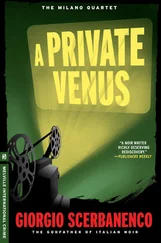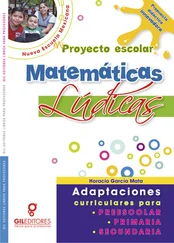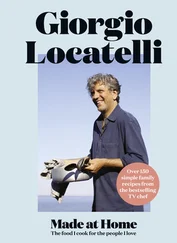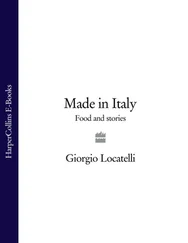In the old days families would have grated or crushed every piece of unused bread to make breadcrumbs in different sizes, because each size has its own purpose. Some would be left large, some sieved fine or medium, and then they would be kept in separate containers, in the way that my grandmother used to keep her breadcrumbs in big jars. Nowadays, most people don’t need to do this all the time, because when you buy your bread in the bakery, you can always pick up a kilogram bag of breadcrumbs at the same time. Whatever bread the bakery doesn’t sell in a day is put into the top of the ovens for two days to dry it out, then grated into breadcrumbs for people to buy. We make our own the same way at Locanda, with the michette, the puffed-up bread rolls ‘with five faces’, which are baked freshly every day in the kitchen, along with all our other breads. Those michette that are left over sit on top of the big bread oven overnight. Even when it is switched off, it retains enough heat to dry the bread and give us all the breadcrumbs we need.
At home making breadcrumbs is such an easy thing to do. If you have cooked something in the oven, when you switch it off, cut your stale bread into slices, put it on a baking tray and leave it in the oven overnight to dry out. Or you could just set your oven to 80°C and put the bread in for an hour. Of course, you need good bread, not the remains of a doughy, sliced loaf – those are only good for the ducks. When the bread has dried out, it is ready for grating. You could also put the bread into a blender and just press the pulse button very quickly, until you have the fineness you want, but I prefer to use a grater, which somehow seems to give an extra fluffiness to the crumbs.
What I also like about grating the crumbs is that they will all be different sizes, much less uniform than if you make them in a machine. These random-sized crumbs, which often have bits of crust mixed in with them, are what I call large crumbs, and are mostly used as a thickener, or in stuffings. If you put them through a fine sieve, they will become medium, and these are the ones that are used to coat fish or meat. If you want fine breadcrumbs, put them through a sieve yet again. Fine crumbs are used to give crunch to the arancini ( Arancini al sapore di mare), or the timbales ( Timballo di riso con pastaand Timballo di maccheroni.)
Medium breadcrumbs are also often toasted dry in the oven, or in a little olive oil in a pan, and these are the ones that are used to scatter over pasta. As I read in one Sicilian cookery book, they need to be toasted until they become ‘il colore di una tonaca di monaco’, the colour of a monk’s tunic, which helps you to understand how dark they should be – not just golden, but brown.
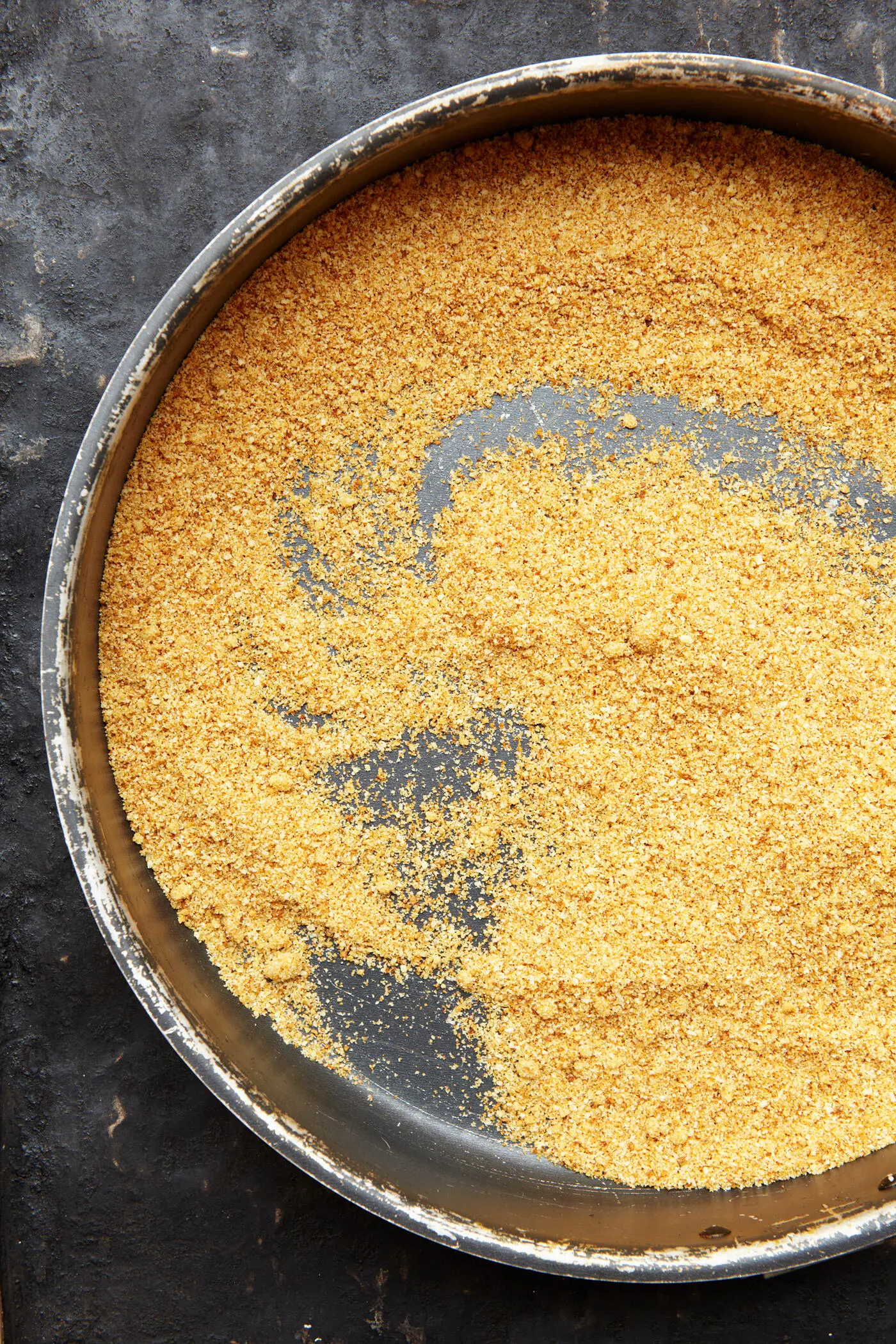
Cáciù all’argintéra
Fried cheese
This is very similar to a dish from Palermo known as formaggio all’argentiera, or the cheese of the silversmith. The story goes that the silversmith invented the dish because when it was cooking it smelt very like rabbit – although he was too poor to eat rabbit, he didn’t want his neighbours to know it.
When you read ‘fried cheese’, you might not think this sounds very enticing, but it is only when you make it that you understand how the typically Sicilian flavours work together to give you something really tasty.
Serves 4
25ml white wine vinegar
25ml white wine
50g sugar
200g breadcrumbs
½ tablespoon garlic oil
2 teaspoons chopped fresh oregano
450g caciocavallo or pecorino cheese ( Caciocavallo cheese)
1 egg, beaten
vegetable oil for deep-frying
To make the sauce, put the vinegar and wine into a pan with the sugar and bring to the boil, stirring until the sugar dissolves. Take off the heat and keep to one side. Put the breadcrumbs, garlic oil and oregano into a blender and whiz until the herbs are finely chopped and the breadcrumbs are infused in the oil. Cut the cheese into pieces about 1cm thick. The thickness is important, otherwise the cheese won’t melt.
Have the beaten egg and herby breadcrumbs ready in two shallow bowls, then pass the strips of cheese through the egg and dip them into the breadcrumbs, turning to coat them. Repeat this three times for each strip, so that you end up with quite a thick coating of breadcrumbs.
Heat some oil in a pan (make sure the pan is big enough so that the oil comes no more than a third of the way up). It should be 180°C. If you don’t have a thermometer, test that it is hot enough by putting in a few breadcrumbs. If they sizzle straight away, the oil is ready. Deep-fry the cheese strips, in batches if necessary, for 2 minutes, until golden on all sides, and serve with the sauce.
Ramacché
Prosciutto and cheese fritters
When you go to the beach on Sundays you see families with boxes of these little fritters, which are eaten cold, along with things like peppers or cauliflowers, dipped in pastella (batter) and deep-fried.
Serves 4
30g unsalted butter
a small pinch of salt
150g plain flour, plus more as needed
3 large eggs
150g prosciutto crudo, diced
100g caciocavallo or pecorino cheese, grated
2 tablespoons parsley and garlic
sunflower oil for deep-frying
Put the butter and salt into a pan with 220ml of water and bring to the boil, then remove the pan from the heat and stir in the flour with a wooden spoon. Put the pan back on the heat and work the mixture continuously with the spoon until it comes together in a solid ball of dough. Take off the heat again and let it cool, then put the dough into a food mixer with a paddle, add the eggs one by one and mix until they are all incorporated.
Add the prosciutto, cheese and the parsley and garlic, and continue to mix. The dough will be quite soft.
Heat several centimetres of oil in a pan (make sure the oil comes no higher than a third of the way up). It should be 180°C. If you don’t have a thermometer, test that the oil is hot enough by dropping in a little bit of the dough. If it sizzles the oil is ready.
Moisten a dessertspoon with water, then scoop out little mounds of dough, slide them carefully into the oil and let them fry gently for about 2 minutes, turning them so they are golden on both sides, and reducing the heat if they start to brown too quickly. Remove the ramacché with a slotted spoon, drain on kitchen paper, and serve hot.
Pizza alla siciliana
Sicilian pizza
In every bakery all over Sicily, there is freshly made pizza, cut into pieces, ready for people to take home. I always buy some, along with the different breads, to have as an antipasto. And if you go into the local bar and have an aperitivo, they will give you a little pizza to eat with it.
The difference between these pizzas and the ones we are more familiar with elsewhere in Italy is that there is not much use of mozzarella. There are no buffalo on the island because they need to wallow in mud and water, so the mozzarella di bufala is always brought in from Campania, just outside Naples. There are also very few herds of cows, so the production even of cow’s milk mozzarella is fairly small. Instead, the concentration is on typical Sicilian ingredients, such as olives, anchovies and tomatoes, scattered with tuma, the local fresh, unsalted sheep’s milk cheese.
You need to choose good-quality black olives, with the stones still in, then pit them yourself – because the intense olive flavour is concentrated around the stone. You must remember that black olives aren’t actually black at all, but a deep purple-brown, depending on the variety. They are olives that have started out green but have been allowed to mature on the tree. As their colour darkens, their flavour becomes more intense and they become softer and more oily. Avoid the shiny jet black ones that you find on many commercial pizzas, or in jars in the supermarket, which are something different completely. These are actually green olives that have been put into a water bath with oxygen running through it, to turn them black, so that manufacturers can market them as a black olive that has the firmness of a young green olive. They just taste insipid, and nothing like a real ‘black’ olive.
Читать дальше


